| کد مقاله | کد نشریه | سال انتشار | مقاله انگلیسی | نسخه تمام متن |
|---|---|---|---|---|
| 87403 | 159249 | 2012 | 6 صفحه PDF | دانلود رایگان |

Cavity nesting birds invest considerable time and effort into the construction of nests. The investment can be particularly high for species such as the black woodpecker (Dryocopus martius) that selects living trees as nest substrates. However, the investment may be reduced if fungal rot is present to help soften the wood. We used Resistograph drills to objectively assess fungal decay and tested whether black woodpeckers preferred trees with heart rot as sites for cavity starts. In doing so we also examined the distribution of fungal decay across the tree radius, analysed location of cavity starts with respect to proximity to heart rot, and evaluated wood condition at fresh and old cavity starts. Heart rot was significantly more common in beeches (Fagus sylvatica) with cavity starts than in random reference beeches. Fungal decay was not evenly distributed across the tree radius, but was more prevalent both in the central and outer thirds than in the middle third. Distance to heart rot was smaller from cavity starts than from random drills, suggesting a preference to initiate cavities close to heart rot. Wood density at fresh cavity starts was significantly higher than at old cavity starts. Collectively, these findings imply that black woodpeckers prefer to excavate cavity starts in beeches with heart rot, which the woodpeckers can detect based on cues unavailable to humans. The decay is reducing the energy expenditure of the black woodpecker and is a part of the long time excavation strategy. The cavity starts are an important factor in the process of excavating the large black woodpecker cavities in beech that enhance biodiversity in managed forests. Future studies should attempt to uncover the mechanisms woodpeckers use in selecting the locations of cavity starts.
► We found black woodpeckers significantly preferred trees with heart rot inside the stems although no decay is visible.
► The woodpeckers choose the position of shortest distance to the decay.
► Often they do not finish the cavity the next few years.
► Returning to old cavity starts after years less effort is needed to excavate a cavity in a hardwood species.
► Short term beech management questions this pattern of behaviour and may influence ecosystem biodiversity.
Journal: Forest Ecology and Management - Volume 271, 1 May 2012, Pages 98–103